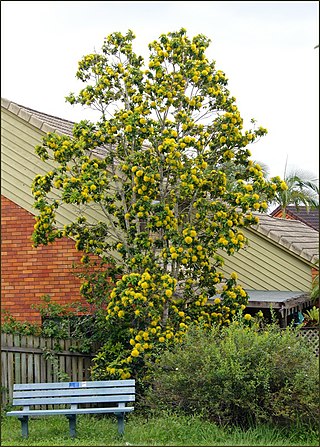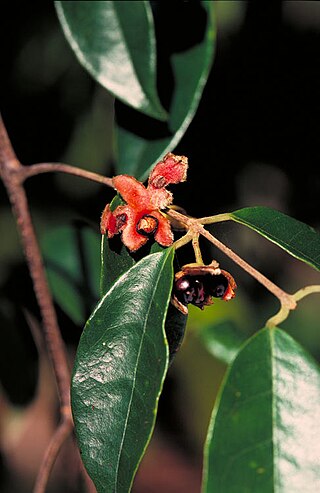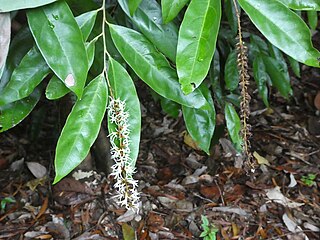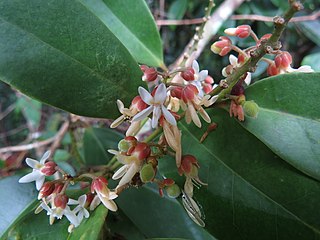
Floydia is a monotypic genus of plants in the macadamia family Proteaceae which is endemic to Australia. The sole described species is Floydia praealta, commonly known as the ball nut. It is a somewhat rare tree found only growing in the rainforests of southeastern Queensland and northeastern New South Wales. The tree has a superficial resemblance to the closely related Macadamia and could be confused with them. The fruit of F. praealta is poisonous.

Canarium australianum, commonly known as scrub turpentine, is a species of tree in the family Burseraceae native to Australia and Papua New Guinea. Other common names include mango bark, carrot wood, parsnip wood, Melville Island white beech and brown cudgerie.

Xanthostemon chrysanthus, commonly known as golden penda, is a species of tree in the myrtle family Myrtaceae which is endemic to north eastern Queensland, Australia. It is a popular garden plant with showy yellow blooms, and is the floral emblem of the city of Cairns.

Phaleria clerodendron, commonly known as scented daphne, scented phaleria or rosy apple, is an evergreen tree or tall shrub in the family Thymelaeaceae. It is endemic to the rainforests of north-eastern Queensland, Australia.

Buckinghamia celsissima, commonly known as the ivory curl tree, ivory curl flower or spotted silky oak, is a species of tree in the family Proteaceae. It is endemic to the tropical rainforests of northeastern Queensland, Australia.

Carnarvonia araliifolia, commonly known as the red oak, red silky oak, Caledonian oak or elephant's foot, is the sole species in the monotypic genus Carnarvonia, a member of the Proteaceae plant family. It is endemic to the rainforests of northeastern Queensland.

Palmeria scandens, commonly known as anchor vine or pomegranate vine, is a species of flowering plant in the family Monimiaceae and is native to Queensland, New South Wales and New Guinea. It is a woody vine with elliptic to oblong leaves and male and female flowers borne on separate plants, male flowers usually with thirty to forty stamens and female flowers with about ten carpels. The fruit is green, splitting to form a pinkish receptacle with 3 to 7 black or red drupes.

Palaquium galactoxylum, commonly known as Cairns pencil cedar, Daintree maple or red silkwood, is a species of plants in the star apple family Sapotaceae which is endemic to rainforests of New Guinea and northern Australia. It can produce spectacularly large buttress roots.

Atractocarpus hirtus, commonly known as the hairy gardenia or native loquat, is a plant in the coffee family Rubiaceae, a large family of some 6,500 species with a cosmopolitan distribution. This species is endemic to northeastern Queensland, Australia.

Neostrearia is a monotypic genus - i.e. a genus containing only one species - of plants in the witch-hazel family Hamamelidaceae. It is the second described of three monotypic Australian genera in this family, the others being Ostrearia and Noahdendron. It is most closely related to these genera, as well as Trichocladus from southern Africa and Dicoryphe from Madagascar, and together these five genera form a distinct clade within Hamamelidaceae.

Acalypha lyonsii, commonly known as Lyon's acalypha is a shrub in the spurge family Euphorbiaceae that is only found in the vicinity of Cairns, Queensland, Australia.

Hypserpa laurina is a slender twining climber in the plant family Menispermaceae. It is native to New Guinea and northeastern Queensland in Australia.

Xanthophyllum octandrum, commonly known as Macintyre's boxwood, false jitta, yellow boxwood or sovereignwood, is a slow-growing tree in the milkwort family Polygalaceae which has the potential to reach thousands of years of age. It is endemic to coastal northeastern Queensland, Australia.

Harpullia rhyticarpa, commonly known as slender harpullia, is a plant in the family Sapindaceae which is endemic to the rainforests northeastern Queensland, Australia.

Diploglottis diphyllostegia, commonly known as the northern tamarind, native tamarind or wild tamarind, is a tree in the lychee family Sapindaceae which is endemic to Queensland, Australia. It is an attractive tree with potential in cultivation, with a dense crown of dark green leaves and masses of fruit in spring and summer.

Actephila foetida is a plant in the family Phyllanthaceae that is found only in a very restricted range within the Wet Tropics bioregion of Queensland, Australia. It was first described in 1927.

Buchanania mangoides, commonly known as plum tree, is a plant in the mango and cashew family Anacardiaceae native to Queensland, Australia. It was first described in 1869.

Peperomia bellendenkerensis is a plant in the pepper family Piperaceae found only in the Wet Tropics bioregion of Queensland, Australia.

Peperomia hunteriana is a plant in the pepper family Piperaceae found only in the Wet Tropics bioregion of Queensland, Australia.

Cupaniopsis foveolata, commonly known as narrow-leaved tuckeroo, white tamarind or toothed tuckeroo, is a plant in the maple and lychee family Sapindaceae found in eastern Queensland and New South Wales, Australia.

























